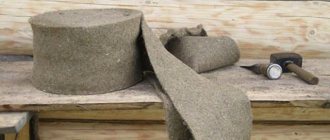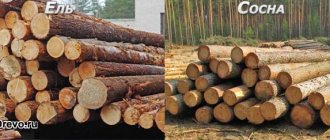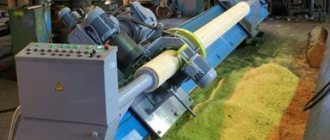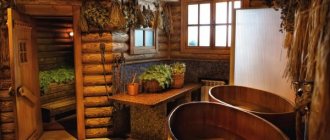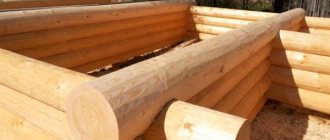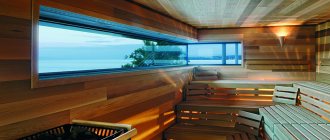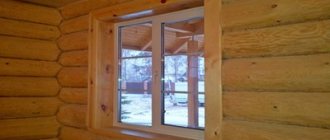White on black. We share our experience in wood bleaching
Blackening and blue discoloration that appears on the surface of wood is not a defect that one can turn a blind eye to. However, solving this problem today is not difficult. The simplest and most effective method is chemical bleaching. It returns the tree to a healthy appearance, completely preserves its structure and prevents the development of a favorable environment for wood-destroying fungi. It sounds simple, but in reality many questions arise. Believe me, we know this firsthand. Therefore, we invite you to a conversation in which we will share our knowledge and experience of working with bleaches.
How does bleach work?
The easiest way to restore the appearance of wood is chemical bleaching. It is used not only when affected by mold or wood-staining fungi. Lightening agents are also used to update aged boards or when you simply need to lighten the tone of the existing material.
Bleaching agents applied to the surface of wood discolor the pigment bonds of lignin. This occurs due to the destruction of chromophore groups - atoms that determine the color of a chemical compound. Thus, bleach only affects the color of wood, without changing its structure and physicochemical properties. In addition, the active components of whiteness discolor the cells of wood-staining fungi.
Briefly about the main thing
Products that bleach wood surfaces are divided into chlorine and non-chlorine. The former cope better with fungi, the latter are more often used to restore the color of old wood. But they do not protect it from discoloration in the future. The wood may darken again from ultraviolet rays or wood-staining bacteria. To prevent this from happening, darkened structures need to be treated as early as possible, before the fungus goes deeper, then antiseptically carry out and a protective coating is applied.
Ratings 0
There are quite a few bleaches for wood. Which one is better to choose?
Indeed, there are many compositions for bleaching wood. Without going into chemical complications, they can all be divided into two large categories: those containing chlorine and those that do not. The first group includes compositions based on sodium hypochlorite, bleach, and chlorine dioxide. The second includes oxalic acid, various kinds of salts and alkalis in combination with hydrogen peroxide, ethanoic (acetic) acid, ammonia, ozone. Most of the products available on the market today are non-chlorine bleaches.
Such products are less aggressive and do not have a strong odor (with the exception of ammonia-containing bleaches). They are completely safe and easier to wash off after treatment. Long-term use of such bleaches does not in any way affect the strength and integrity of the wood. Compositions of this type work well on aged wood and materials that have changed color due to prolonged exposure to the sun. The disadvantage of such bleaches compared to chlorine bleaches is their lower intensity of exposure and effectiveness over a relatively short time.
When is the best time to use chlorine-free bleach?
: elimination of small areas of blueness and blackening; bleaching aged and yellowed wood; eliminating dark spots caused by contact with iron; surface treatment in residential premises.
This is a kind of heavy artillery for the fight against wood staining and mold fungi. This category of products is very effective for eliminating large lesions and for the re-emergence of fungal stains on wooden surfaces. Of course, chlorine-containing bleaches have plenty of disadvantages. They have a rather pungent odor, they need to be thoroughly washed off with water, and it is not so easy to control the completeness of the wash. When working with chlorine-containing bleaches, it is very important to follow all recommendations for use specified by the manufacturer. This is especially true when mixed with other compounds - in this case, chlorine bleach can pose a real health hazard.
There are also more serious disadvantages to chlorine-containing products. They penetrate deep into the wood structure, leaving alkali salts there. On the one hand, this is good, because... reagents prevent the development of biological activity in the wood. But at the same time, they destroy its microstructure - gradually the fibers become loose and porous. Due to the presence of salts, wood is more actively saturated with moisture, which in turn makes it more vulnerable to the same fungi. In chlorine bleaches, they try to minimize this undesirable effect, but it is unrealistic to eliminate it completely.
When is the best time to use chlorine bleach?
: combating deep pollution and large areas; repeated appearance of blueness and blackening; Can be used for both external and internal work, but with strict adherence to all manufacturer’s instructions.
About auxiliary components
In addition to the basic reagents responsible for the discoloration of lignin pigment bonds and wood-staining fungal cells, modern products contain various auxiliary substances that improve the effect of the compositions.
Stabilizers
prolong the viability of whitening components.
Fungicidal additives
antisepticize the treated surface and protect it from destructive biological activity.
Agents and catalysts
improve the penetration of the bleach into the wood.
Thickeners
allow for better treatment of large surfaces, and
surfactants
improve washability.
Protective varnishes for lining processing
When deciding on the best way to impregnate the lining in a bathhouse, it is important to take into account that ordinary paint and varnish compositions cannot be used for these purposes. Paint and varnish reduce the breathability of wood, which can lead to the accumulation of excess moisture in the fibers and further rotting.
The optimal choice is water-based moisture-proof varnishes with high thermal insulation characteristics, used to create a durable polymer coating.
Varnish compositions are of the following types:
- Acrylic. Universal products designed for treating bath surfaces. They protect wood from contamination, are easy to apply and dry quickly. The only drawback of the compositions is the appearance of an unpleasant odor when heated, so they can be used for the dressing room and rest room.
- Alkyd. Provide reliable protection from high humidity and hot steam. Disadvantages include: long drying time, unpleasant odor.
- Water-based. Environmentally friendly and safe compositions, dry quickly and do not emit a strong odor when heated. It is allowed to process the lining in a bath in the washing and steam departments.
- Polyurethane. Used for internal and external protection of bath surfaces from color fading. They can be completely transparent or colored.
- Acrylic-polyurethane. The formulations are designed to combat mold and pathogenic microorganisms. In addition, they give the wood an attractive shine and polishing effect.
How to cover wooden lining in various functional areas of the bathhouse? For this you can use the following compositions:
- “Eurotex Sauna” is an acrylic-based varnish that contains wax and an antiseptic. It reliably protects the wooden surface from high temperatures. In addition, the varnish prevents the accumulation of moisture, the formation of mold and the development of microorganisms. The product is absolutely safe and has a neutral odor.
- Interier Sauna is a colorless antiseptic acrylic composition designed to protect wooden surfaces. Not used for ceilings.
- “Pirilax” is a complex of antiseptic preparations used in old and new baths to protect the lining from contamination, fire and corrosion. The compositions are ideal for rooms with special operating conditions - steam rooms, dressing rooms and washing rooms.
When is the best time to bleach wood?
Bleaching is best carried out at a temperature of 17–22 ° C and air humidity of 50-65%. Under such conditions, the brightening composition penetrates most deeply into the structure of the material and acts there with maximum efficiency. The use of bleaches is also allowed at lower temperatures, but in most cases it should not be lower than +5 °C. You will always find exact recommendations in this regard in the instructions for use of a particular product.
As for the interior, here wood remains at risk all year round. Already at +5 °C and humidity above 23%, wood-staining fungi have all the necessary conditions to spread their spores and color the surface of the wood black, blue or green. They multiply especially rapidly at high temperatures and humidity. Those who have their own steam room will certainly understand what we are talking about. That is why, if even small pockets of blackness are detected in the bathhouse, regardless of the time of year, measures should be taken as soon as possible. Otherwise, the problem will very quickly become widespread.
Basic Rules
How to clean soot in a bath? There are certain rules for this. For example, wooden surfaces covered with a layer of soot should not be wetted.
Wood is a hygroscopic material that quickly absorbs moisture. Together with water, everything that has settled on the surface - soot, soot, bodily fluids, etc. - will be absorbed into the structure of wooden elements. Once the dirt is absorbed into the surface of the wood, it will be almost impossible to clean the shelves in the bathhouse, walls, floor or ceiling.
Therefore, when deciding how to clean soot from walls or floors in a bathhouse, you should categorically refuse to use such substances and materials as:
- laundry soap;
- water;
- sponges;
- spray guns.
All of the above products can only be used for final cleaning of wooden surfaces, when the carbon deposits have already been cleaned dry.
All work on cleaning the bathhouse from soot and soot must be carried out using special protective equipment:
- blind safety glasses;
- respirator;
- thick rubber gloves.
All this will help prevent combustion products from entering the respiratory tract.
Is it possible to bleach wood with regular bleach?
In short
: it is possible, but not necessary.
It bleaches worse, leaves yellow stains and destroys the structure of the wood. The main active component of household bleach is sodium hypochlorite, which consists of 95% active chlorine. This aggressive compound, when reacting with the surface of wood, forms a salt residue, which has a destructive effect on the structure of the material. That is why when working with chlorine-containing bleaches, it is fundamentally important not to delay the removal.
Since ordinary whiteness acts more slowly than specialized products, it requires longer exposure. During this time, alkali salts penetrate deeply into the thickness of the wood and remain there after washing. The prolonged aggressive reaction destroys lignin and cellulose, causing the fibers to become loose and porous. At the same time, the salts that remain in the structure of the tree begin to accumulate moisture, which significantly accelerates the process of degradation of the physical and chemical properties of wood.
The problem can be partially solved by thoroughly washing off the whiteness with a solution of acetic or citric acid (4%). But this significantly complicates the treatment cycle for large surfaces and is often not worth the effort, since the effect of homemade bleaches is always lower. Thus, there is no point in reinventing the wheel - you are unlikely to go broke buying a normal product, but the result will be noticeably better. This applies not only to whiteness, but also to other artisanal bleaches.
Why does the chimney become dirty?
How to clean a chimney in a bathhouse depends on the nature of the contamination. With use, types of clogging may occur such as:
- soot and soot, which accumulates very quickly when burning household waste;
- condensation that forms due to irregular use of the bathhouse;
- foreign objects accidentally falling into the chimney.
All of these types of contaminants ultimately impede the free circulation of air and the escape of smoke through the chimney. This may cause carbon monoxide poisoning. Condensate is a weakly concentrated acid solution. Under its influence, the chimney masonry begins to collapse from resinous deposits.
If you use a sauna regularly, you need to make a schedule and determine in advance when and how to clean the pipe in the sauna. Carrying out such work regularly will preserve the chimney and stove and allow you to use the sauna without any problems.
The chimney and pipe in the bathhouse are cleaned chemically and/or mechanically. In a special store you can purchase liquids and/or powders for cleaning the chimney. Detailed instructions are printed on the packaging. After reading it, it will become clear how to clean a pipe in a bathhouse.
A good answer to the question of how to clean soot in a bathhouse that has accumulated in a chimney would be a “log chimney sweep.” It is impregnated with special chemicals. During combustion in the furnace, smoke of a special composition is released. As a result, the soot becomes soft and pliable. After 2 or 3 days it can be removed with brushes without much difficulty.
For mechanical cleaning of the chimney you will need the following tools and devices:
- rope and/or rope;
- weight (ball);
- brush-ruff (preferably on a thin metal cable).
First you need to check the safety of the structure. Then you need to remove any objects that accidentally got into them from the pipe and chimney. For this purpose, a brush-ruff is used, selected according to the size and shape of the pipe.
A special modern brush will make cleaning work easier. It comes with a handle consisting of several links. This allows you to adjust the length of the brush as needed. During cleaning work, any brush must be moved inside the pipe, gradually moving it lower and lower.
Such work must be performed in a special set of clothing, which must include:
- overalls or suit;
- respirator;
- gloves;
- protective glasses.
If the chimney is not very dirty, you can call a specialist. He will clean it using a special high-power vacuum cleaner. This will remove soot from the chimney through the firebox opening. The use of special means will help resolve the issue of how to clean the chimney of contaminants and how to clean the pipe of soot in a bathhouse.
Blackening of wood from contact with metal. How to distinguish from mold and what to do about it?
Blackening of wood from contact with iron is often confused with mold, but this process has a completely different nature. Dark stains - from light brown to gray-black - can appear around fasteners, fittings, or simply from prolonged contact of wood with iron objects. Unlike biological activity, it is a chemical reaction. It occurs due to the interaction of iron ions and phenolic components of wood. The catalyst for the reaction is moisture.
Such blackening is indeed very similar to dark mold lesions. You can distinguish one problem from another by a number of signs. The most obvious of them is the appearance of a fire around a metal object. Also, unlike mold, iron contamination appears very quickly (usually after rain), has a small lesion and does not grow.
An effective method for removing such blackness is to use a 3-5% aqueous solution of oxalic acid (30-50 grams of acid per 1 liter of water) followed by rinsing. The solution is mixed immediately before application using warm (30°C) boiled water.
Source
Bath water purification
The required amount of water for hygiene procedures is often provided by drawing water from a nearby reservoir, well or borehole. Before use, it is necessary to thoroughly clean the bath water from various impurities, silt, sand, and small pebbles.
The main methods of water purification are filtration and sedimentation. You can buy a special water filter in a store or make it yourself. For this you can use a fine mesh.
To settle, water is poured into a large tank about a day before its intended use. During this time, all impurities will gradually settle to the bottom of the tank. From above it will be possible to take clean water suitable for hygiene procedures.
The basic rule: the settled water should be taken from above, trying not to raise sediment. The water is not used until the end. It is better to pour the remains into the drainage well along with the sediment. Therefore, you need to prepare water with a reserve.
Antiseptic for baths and saunas: what is it for, how does it help protect health
Wood, as a material of plant origin, contains many chemical compounds. These include polysaccharides, lignin and other elements that are of interest to other organisms. Imagine if all the wood grown on the planet remained for a long time after death in the form of dead wood, what would this planet look like? Only thanks to the “operational work” of bacteria, fungi and insects, the Earth did not turn into a plant cemetery, so you should not be surprised that a board left in a humid environment or on the street begins to quickly deteriorate.
If you are interested in checking out quality products on the topic of this article, we suggest you follow the link
Grinding
If the lining has darkened slightly, how can you lighten it by sanding? In the case where the blackening has not penetrated to a great depth, you need to take an angle grinder with a power of up to a kilowatt for a wheel with a diameter of 125 mm. For doing the work yourself, this is the safest and easiest to use option. An ideal machine is one in which the shaft protrudes slightly above the disk, which makes work as convenient as possible, regardless of the characteristics of the surface.
You can remove the protective cover from the machine. This is a safety precaution, but it allows you to get into all the grooves of the wood panels to thoroughly clean them.
Craftsmen recommend using a flap grinding wheel. This is a special device with ribs over the entire surface. The optimal grain size is about 40 units (on sale you can find wheels from 36 to 150). The lower this value, the rougher the processing will be. To completely eliminate blackness, it is usually necessary to remove the top layer of wood 3 or more millimeters thick.
What are wood preservatives used for?
Considering the fact that it is not customary to paint or varnish the interiors of wooden bathhouses, you can imagine what awaits unprepared wooden furniture, walls, ceilings and other parts in the typical humidity of a bathhouse. To prepare the material for use in a humid and aggressive environment, use an antiseptic for baths and saunas. The main properties of this drug:
Buy in bulk at a competitive price
I am raw html block. Click edit button to change this html
If stains and grayness have already appeared, there is no need to despair; there are ways to bleach wood, which we will discuss further.
Povagonke.ru
It has long been customary to line the interior space in a bathhouse with material made from natural wood. This is the most environmentally friendly and aesthetic material, which, in addition, emits a unique natural aroma, so the interior of the bathhouse can be decorated with clapboard.
Choose your trim material carefully to ensure it looks beautiful.
The negative side of this material is its impracticality, which is associated with instability to moisture. In a room with high humidity, wooden panels can become deformed over time and become moldy. Therefore, even at the construction stage, before commissioning, it is important to properly process the material.
What is bleach and how is it different from antiseptic?
Despite the fact that many people confuse or do not distinguish one from the other at all, there are differences and they are significant. You can guess this even from the name, but it’s still better to say it clearly. So, what is bleach for baths and saunas?
This drug contains substances that break down or otherwise interact with pigments secreted by coloring fungi and bacteria, and eliminate the natural gray coating that occurs from oxidation and exposure to ultraviolet radiation. As a result, the treated surface may take on its original or lighter shade, in addition, stains from mold and other parasites will disappear.
So, the use of bleaches is recommended to destroy the infection that has already manifested itself, and also, and even to a greater extent, to eliminate traces of pest activity and return the material to its normal color. In addition, bleaching allows you to manipulate the tone of healthy wood and create an interesting texture.
Only the best products from GOODHIM for the protection and decoration of wooden structures
Fighting fungus
In the bathhouse there are ideal conditions for the formation of fungus; heat and moisture contribute to the rapid destruction of wooden lining. Therefore, the panels should be protected with special compounds. In addition to the fact that they allow you to whiten the surface, they also prevent the formation of fungus and mold:
- Snegurochka-2 - this composition completely disinfects and bleaches even wood that has darkened over time.
- Supi Saunapesu is a Finnish-made product created for disinfecting and bleaching lining in a steam room.
After processing wooden lining, you need to carefully monitor and care for the surface. After each use, it is necessary to thoroughly ventilate and dry the room and clean it. In winter, you should cool the bathhouse with frosty air.
If you do everything correctly and carefully monitor the premises, then the next major renovation in the bathhouse will not be soon.
Types of bleaches by composition
As we mentioned, bleaches are different both in composition and in their mechanism of action.
Table. Types of bleaches.
Table. Types of bleaches
It is necessary to understand that any effective bleach poses a danger in terms of toxicity and chemical aggressiveness, especially in direct contact with mucous membranes, skin, and eyes. Therefore, you should choose one or another drug only based on what type of wood you have, what the characteristics of the lesion are, etc. This information is available in the instructions for the drug.
How harmful is bleaching a log house?
When building a wooden bathhouse or house, you really don’t want to use chemicals. Unfortunately, there is no other way to protect the wood. Yes, chemistry is not useful, but fungal spores will not bring any benefit either. Moreover, the most harmful component, chlorine, evaporates quite quickly. He simply cannot remain in an incoherent state for a long time. It evaporates or precipitates in the form of chlorides.
Means for “treating” and bleaching wood Lignofix Top (Lignofix Top)
That is why when bleaching log houses inside, it is necessary to provide a draft, and also to work in a respirator. Chlorine fumes, if inhaled, can cause burns to the respiratory tract.
A respirator will not hurt for outdoor work, but there it is not so critical.
And although the chlorine will disappear by the start of the bath, run several fireboxes “idle”. At the same time, you will test the new oven, and also understand a little about how exactly you need to handle it.
If you really don’t want to leave traces of bleach on the wood, you can wash off all residues with water after the drying period specified in the instructions. How effective this is is the question. But, most likely, it will calm you down. At least partly. After washing the logs, immediately wipe them with a dry cloth: there is no need for excess moisture.
If you really don’t want to use chlorine, there is a new composition: Lignofix Top (Lignofix Top). Its manufacturers call it a medicinal antiseptic. It consists of fungicides and insecticides dissolved in water, that is, it acts on fungi and insects. It’s hard to say how harmful it is to human health, but it works well: so far there are no complaints. But this product has only been on the market for a few years, so the shelf life is still short.
Procedure for using bleach and antiseptic
These drugs can be used independently and independently of each other. Antiseptics in general represent a larger group of solutions, which includes transport, washable and non-washable, external and internal, complex fire-bioprotective, tinting, and so on.
The classic scheme for using these two tools is as follows:
In addition, bleach can be used to renew bath utensils and furniture if they have begun to darken, to eliminate pockets of mold and disinfect putrefactive manifestations.
You might be interested
The best wood bleaches from different manufacturers
To decide which bleach or antiseptic to choose, you need to consider the best options available on the market. Some are universal, others are more suitable for repairing or processing log facades, while others are suitable for baths and saunas.
Table. Manufacturers of bleaches and product features.
Bleach manufacturers and product features
We do not claim to be an exhaustive list of the best drugs; we express our personal opinions. If you have experience using other good products, write to us in the comments. The product from GOODHIM has a lot of interesting qualities, so we put it first on the list. What are these qualities:
This is a relatively inexpensive and effective product, made according to a modern recipe using the latest equipment. The product meets Russian and European quality standards.
Sequencing
Specific actions depend on what stage the construction of your bathhouse (house) is at.
Before construction starts
If the logs have just been delivered, and some are already affected by blue staining, they need to be treated with bleach before being placed in the log house. If only part of the materials is affected and there are absolutely clean logs or beams, then it is better to coat only the affected ones, leaving the rest as is.
After treatment with bleach, the surface is treated with an antiseptic (after drying the bleach). Don't forget to process the bowls as well as the ends.
Just don’t get it mixed up: after bleaching, treat not with a finishing film-forming composition, but with a water-based or solvent-based antiseptic (they are not very popular because they are not environmentally friendly). Precisely an antiseptic, preferably of deep penetration, which does not form a film.
If the log did not need bleaching, it is not coated with an antiseptic. The fact is that after drying you will have to sand the frame. And wood treated with an antiseptic does not sand well. If the log is clean, and there is a season ahead with minimal precipitation or low temperatures, then without moisture or heat, fungi will not develop without any treatment.
After drying, the logs or beams are sanded. There is a high probability that all the blue will be removed
After installing the log house, it is covered with a roof and in this state is left to dry out/shrink. There is one point: during this period, you should not cover the cut window and door openings with film. You can fill it with boards, but with cracks so that moisture can escape freely. You can also use vapor-permeable films (if the film has one-sided conductivity, do not confuse which side should be nailed - the rough side facing the street). If the openings are closed tightly, there is a high chance of getting mold or white fungus in addition to the blue. Therefore, take care of ventilation.
Blue of dried logs (timber)
After drying and shrinking, it’s time to polish the frame . This is where the need for bleaching may arise again. If there is blueness, bleach, if not, you don’t need to. Then comes the grinding of the frame. In the process, many minor lesions that the bleach did not remove can be removed mechanically: you will still have to remove the darkened layer of wood, so this may also remove fungus-affected wood.
After the first pass with a grinding machine, the condition of the treated logs is assessed. If there are dark spots, they are treated with bleach again. Only this time you need to act carefully: light spots on wood are no less pleasing than dark ones. Therefore, the sequence is as follows: first, generously moisten the darkened area, and then rub it with a brush, “blurring” the boundaries of the treated area. After the bleach has dried, the frame is sanded with a fine-grain abrasive until smooth.
In case of deep damage, simply sanding is not enough: no one will remove two or three centimeters of wood
Then, they are immediately coated with an antiseptic, fire retardant and finishing composition (for example, Senezh wood protection compositions). You can use combined products, or you can use three different ones. You just need to select compatible compounds.
If it works, take all the products from the same brand: there will be no compatibility problems. If this does not work out, before purchasing a large batch, buy the selected products in small packaging. Use them on some unnecessary piece of wood (cover it with a layer of the last compound applied to the walls) and try how they behave in combination. It is necessary that they do not react and do not stain the wood. For example, some antiseptics in combination with chlorine give a pink color. Also check whether the product lays evenly, does not roll down and how well it is absorbed.
Using the same test, determine how much you like the selected topcoat tone, and how many layers you will need to apply to achieve the desired result.
Before buying a large batch of bleach, antiseptic and paint, test them all on an unnecessary (or invisible) piece of wood
Unfortunately, it is impossible to determine the effectiveness of the protection. Unless you can see if the water will be repelled. After the topcoat has dried, spray the board and see what happens. Drops should roll off but not be absorbed.
What to buy: which wood bleach to choose for your home
Finally, we come to the most important question: “What is the best thing to buy for your own home?” You need to take this seriously, because if it fails, you may face not only problems with damage to the wood or the appearance of the facade, but also health problems.
Firstly , the drug may contain toxic components, especially if it is produced in countries with low safety standards. Such a product can cause harm both during application and later, when it begins to release toxins into the air that people breathe.
Click the button below and make sure of the high quality of the products we offer at their competitive prices
When choosing a specific product, you should proceed from the following criteria:
The first three criteria do not raise questions, since you most likely know where you will use the product, on what wood and for what reason - stains, blueness, grayness, etc. Here it is enough to study the instructions and consult with the seller.
It is much more difficult with the last point, since no one will dissuade you from buying a product that is not of very high quality, since it is the most difficult to sell. There are two options here - buy well-known, well-promoted, but very expensive global brands, or spend time, study reviews, read similar articles and figure out what to buy yourself.
Of the options listed in our table, all are good in their own way, but if you take into account all the pros and cons, you can come to the conclusion that the most interesting option in terms of price and quality will be the GOODHIM DW-400 S.
This is an aqueous solution of chloride compounds with surfactants and stabilizers, harmless to humans and animals. Since use is intended in a bath or sauna, rooms with high temperature and humidity, as well as contact of shelves with skin, there are no allergens or toxins in the composition.
If you need bleach for the facade of a log house or a cottage made of laminated veneer lumber, then you will need another product, which is best selected with the help of a specialist or a trained sales consultant. Often these products have labels such as “facade cleaner,” “wall bleach,” or something similar in the name.
Antiseptics and other products for the protection of wooden structures, tested by time and by our customers
When applying the drug, you can use a sprayer, brush or roller. Be sure to follow safety precautions and protect your eyes, face, hair, exposed areas of the body and hands from direct contact with bleach.
After application, the solution is left on the surface according to the manufacturer's instructions, usually from 30 minutes to several hours depending on the extent of the damage and other factors. Then it is recommended to rinse the bleach thoroughly with water.
Cleanliness in the steam room
The steam room in the bathhouse requires special attention. After all, when using brooms, particles of plant pigment from stems and/or leaves are absorbed into wooden shelves and walls along with moisture. Therefore, the question inevitably arises of how to clean the steam room in a bathhouse to give it a fresh and pleasant look.
The problem of how to clean linden lining in a bathhouse, especially in the steam room, can be solved in different ways. If the wood darkens slightly, you can use special liquid detergents and/or paraffin oil.
The cleaning liquid is applied to the darkened surfaces manually using a piece of foam rubber or a regular sponge. The pre-detergent must be diluted with water. How to do this is detailed in the instructions.
Paraffin oil is gradually applied to pre-dried surfaces using a dry sponge. In this way, you can not only clean the lining in the steam room, but also give the wood water-repellent properties. This will protect the wood trim and various items from severe and rapid contamination.

